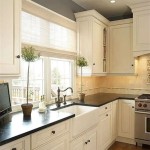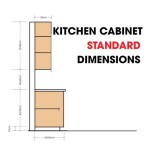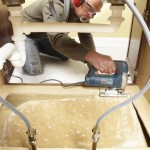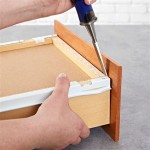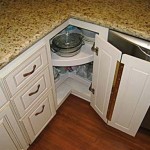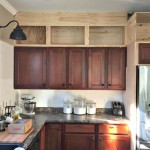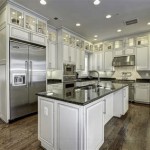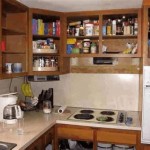Kitchen Cabinets with Glass Fronts: An Aesthetic and Functional Exploration
Kitchen cabinets with glass fronts have experienced a resurgence in popularity, moving beyond a niche design element to become a mainstream choice for homeowners seeking to blend functionality with visual appeal. These cabinets offer a unique opportunity to showcase curated collections, break up the monotony of solid cabinet doors, and introduce light and depth into the kitchen space. Understanding the various aspects of glass-fronted cabinets, including their design options, materials, installation considerations, and maintenance requirements, is crucial for making an informed decision about incorporating them into a kitchen renovation or new build.
The evolution of glass-fronted kitchen cabinets can be traced back to traditional pantry displays and china cabinets, where fine china and treasured possessions were proudly exhibited. Modern adaptations have broadened their appeal beyond purely decorative functions, integrating them seamlessly into contemporary kitchen designs. Advances in glass technology, hardware, and cabinet construction have contributed to the versatility and durability of these cabinets, making them a practical choice for everyday use.
The aesthetic impact of glass-fronted cabinets is undeniable. They allow homeowners to personalize their kitchens by displaying items that reflect their individual style and interests. This transparency can also create a sense of openness and spaciousness, particularly in smaller kitchens where visual clutter can be overwhelming. However, the success of glass-fronted cabinets hinges on careful planning and execution. A poorly curated or disorganized display can detract from the overall aesthetic and create the opposite effect, making the kitchen appear cluttered and uninviting.
Design Considerations for Glass-Fronted Cabinets
Selecting the right design for glass-fronted cabinets involves careful consideration of several factors, including the overall kitchen style, the desired level of transparency, and the items that will be displayed. The choice of glass itself is a crucial element, with options ranging from clear glass to frosted, textured, or leaded glass, each offering a distinct aesthetic and level of privacy. Clear glass provides maximum visibility, making it ideal for showcasing carefully arranged collections. Frosted glass, on the other hand, offers a more diffused view, concealing some of the contents while still allowing light to pass through. Textured glass adds visual interest and can obscure the contents further, while leaded glass introduces a touch of traditional elegance.
Cabinet door styles also play a significant role in the overall design. Options include framed, frameless, and inset doors, each with its own distinct look and feel. Framed doors, with a surrounding frame that adds structural integrity, are a classic choice that can be adapted to various design styles. Frameless doors, also known as European-style cabinets, offer a sleek, contemporary look with minimal visible hardware. Inset doors, which sit flush with the cabinet frame, provide a clean, streamlined appearance and are often found in high-end kitchens.
The placement of glass-fronted cabinets within the kitchen layout is another key consideration. They are often used strategically to highlight specific areas, such as above the sink or around the range hood. Combining glass-fronted cabinets with solid-door cabinets can create a balanced and visually appealing design. Consider using glass-fronted cabinets to display decorative items or frequently used dishware, while reserving solid-door cabinets for storing less visually appealing items or those that need to be concealed.
Lighting is also an important factor to consider when designing with glass-fronted cabinets. Interior cabinet lighting can accentuate the displayed items and create a warm, inviting glow. LED strip lights are a popular choice for under-cabinet lighting, providing bright, energy-efficient illumination. Consider adding dimmer switches to control the intensity of the lighting and create different moods. The type of light fixture and its placement can significantly impact the overall aesthetic and should be carefully considered in the design process.
Hardware choices, such as knobs and pulls, should complement the overall style of the kitchen and the design of the glass-fronted cabinets. Options range from sleek, modern pulls to ornate, traditional knobs. Consider the finish of the hardware and how it will coordinate with the other finishes in the kitchen, such as the faucets and appliances. The size and shape of the hardware should also be carefully considered to ensure that it is comfortable to use and visually appealing.
Material Choices and Construction
The materials used in the construction of glass-fronted kitchen cabinets significantly impact their durability, aesthetics, and cost. The cabinet boxes themselves are typically constructed from plywood, particleboard, or MDF (medium-density fiberboard). Plywood is a strong and durable option that is resistant to moisture, making it a good choice for kitchens. Particleboard is a more affordable option but is less resistant to moisture and may not be as durable as plywood. MDF is a smooth and stable material that is often used for painted cabinets.
The frames of glass-fronted cabinets can be made from wood, metal, or composite materials. Wood frames offer a classic, warm look and can be stained or painted to match the overall kitchen design. Metal frames provide a sleek, contemporary look and are often used in modern kitchens. Composite materials offer a durable and affordable alternative to wood and metal.
The type of glass used in the cabinet doors is another important consideration. Tempered glass is a safety glass that is designed to shatter into small, harmless pieces if it breaks. This is a recommended option for kitchen cabinets, particularly in households with children or pets. Laminated glass consists of two layers of glass bonded together with a layer of plastic, providing additional strength and safety. Acrylic glass, also known as Plexiglas, is a lightweight and shatter-resistant alternative to traditional glass.
The construction of the cabinet doors also affects their durability and aesthetics. Solid wood doors are a classic choice that offers a warm, natural look. Veneer doors consist of a thin layer of wood applied over a core material, such as particleboard or MDF. Thermofoil doors are made by wrapping a layer of vinyl over a core material, providing a durable and easy-to-clean surface. The method of attaching the glass to the door frame is also important. The glass can be held in place with glazing points, silicone sealant, or a combination of both. Proper installation is essential to ensure that the glass is securely held in place and that the cabinet doors are durable and long-lasting.
Maintaining and Organizing Glass-Fronted Cabinets
Maintaining glass-fronted kitchen cabinets requires regular cleaning to keep them looking their best. The glass should be cleaned regularly with a glass cleaner to remove fingerprints, smudges, and dust. Avoid using abrasive cleaners or scouring pads, as these can scratch the glass. The cabinet frames can be cleaned with a damp cloth and mild soap. Be sure to dry the frames thoroughly to prevent water damage.
Organization is key to making the most of glass-fronted cabinets. Carefully curated displays will enhance the overall aesthetic of the kitchen, while cluttered or disorganized cabinets can detract from it. Consider using matching dishware and glassware to create a cohesive and visually appealing look. Group items together by color or function to create a sense of order. Use risers or shelves to create visual interest and maximize storage space.
Decluttering is an essential part of maintaining glass-fronted cabinets. Regularly remove items that are no longer used or needed to prevent clutter from accumulating. Consider donating or selling unwanted items to keep the cabinets organized and clutter-free. Implementing a regular decluttering routine will help to maintain the aesthetic appeal of the cabinets and prevent them from becoming overwhelmed with unnecessary items.
The interior of glass-fronted cabinets can also be enhanced with decorative elements. Consider adding wallpaper or fabric to the back of the cabinets to create a visually interesting backdrop for the displayed items. The color and pattern of the wallpaper or fabric should complement the overall style of the kitchen and the colors of the displayed items. This can add depth and dimension to the cabinets and create a more personalized look.
Ultimately, the success of glass-fronted kitchen cabinets depends on a combination of careful planning, thoughtful design, and diligent maintenance. By considering the various aspects of these cabinets, homeowners can create a kitchen that is both functional and aesthetically pleasing. The transparency of glass-fronted cabinets allows for personal expression and creates a sense of openness and spaciousness, making them a valuable addition to any kitchen design.

The Best Ways To Use Glass Front Cabinets In A Kitchen Design Cabinet Doors Upper

Ideas And Expert Tips On Glass Kitchen Cabinet Doors Decoholic Cabinets

Designing Your Kitchen With Glass Fronted Cabinets

Why Choose Glass Front Kitchen Cabinets Woodmaster Kitchens

Eight Elegant Ways To Design Glass Fronted Kitchen Cabinets

Are Glass Front Kitchen Cabinets A Good Idea

Glass Front White Kitchen Cabinets Accented With Shelves Are Fixed Against Decorating Above

Glass Front Kitchen Cabinets Design Ideas
:strip_icc()/101762987-6ff51afda1de4a9da290dfe4af5036d8.jpg?strip=all)
Glass Front Cabinetry

Glass Front Cabinets Popular Choices Town Country Living
Related Posts

